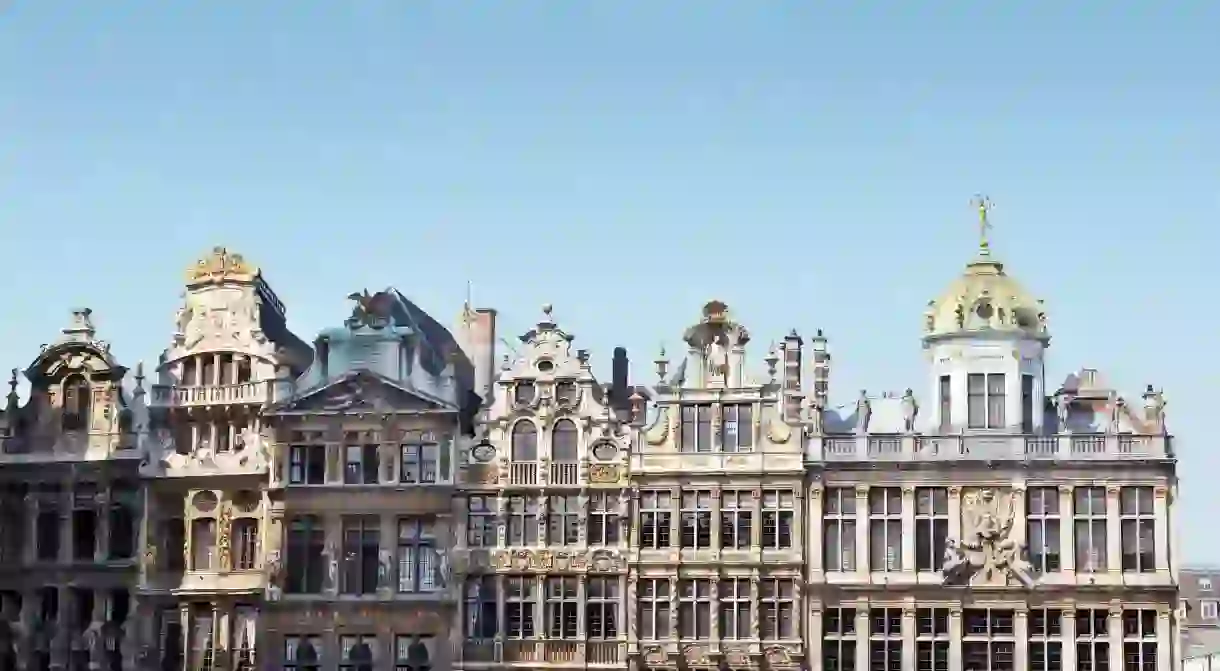An Architecture Lover’s Guide to Brussels

Where to even begin exploring all the architectural treasures Brussels holds? As you walk around town, it quickly becomes clear that the capital of Art Nouveau has much more than just Victor Horta mansions to brag about. Here is an introduction to Brussels’ architectural highlights, divided up into five styles.
Art Nouveau:
Maison Saint-Cyr by Gustave Strauven
Architectural Landmark

It was Gustave Strauven – mentored by Horta and assistant to the creation of Hôtel van Eetvelde – who took over the Art Nouveau baton from the Modernist pioneer. His splashy Maison Saint-Cyr on Ambiorix Square reveals an unequalled commitment to wrought iron embellishments and an overall flamboyant aesthetic.
Maison Cauchie by Paul Cauchie
Architectural Landmark, Museum

Saved by the grace of two Art Nouveau-loving owners, the former home of artist couple Paul and Caroline Cauchie is now open to the public every first weekend of the month. Most striking, however, is its façade, embellished by Paul Cauchie in the sgraffito wall paintings for which he would become known. One of the golden murals bears the words “Par nous, pour nous”, or “By us, for us”, indicating the duo’s loving decoration of their own living space.
Musical Instrument Museum by Paul Saintenoy
Building, Concert Hall, Museum, Shop, Store

Victor Horta’s Major Townhouses
Museum, Architectural Landmark

So many Horta gems, so little time. The European capital is dotted with buildings from Belgium’s own architecture revolutionary and Art Nouveau’s leading light, Victor Horta. In case of limited time, the four townhouses selected by UNESCO to be on their World Heritage List are a good place to start. Atelier Horta, Hôtel Tassel, Hôtel Solvay and Hôtel van Eetvelde are all revolutionary in their use of industrial materials like steel and glass, wrought-iron features, meticulous wood panelling, and sunbathed living spaces.
Art Deco:
Flagey by Joseph Diongre
Architectural Landmark
A steamboat-shaped building rising up beside Ixelles’ most famous square and looking out over its pond, the Flagey is a fine example of Art Deco craftsmanship. Besides designing its monumental look, Joseph Diongre created studios with world-class acoustics for the former national radio and television institute.
Koekelberg Basilica by Albert Van Huffel
Historical Landmark, Architectural Landmark

This huge edifice on the Koekelberg hill is the largest Art Deco building in the world and one of the largest basilicas. For decades, it seemed as if the ambitious masterpiece would never be completed, with construction detained by two World Wars and a persistent lack of funds. Now Albert Van Huffel’s Art Deco place of worship dominates Brussels’ western skyline with its green copper dome.
L’Archiduc by F. Van Ruyskensvelde
Architectural Landmark
The L’Archiduc bar has known many lives. From a discreet rendez-vous place for businessmen and their lovers, to jazz temples frequented by the likes of Miles Davis, it’s easy to see why the Art Deco establishment continues to exercise such a gravitational pull. A buzzer and cast-iron door will let you enter an atmospheric setting complete with original wooden benches, rosewood bar and art gallery, all elegantly combined by F Van Ruyskensvelde.
Neoclassical:
Place Royale by Barnabé Guimard
Architectural Landmark

Rebuilt after being gutted by fire, Brussels’ spacious Royal Square exudes Neoclassical grandeur to the fullest. The symmetrical building blocks that surround it and its central Godfrey of Bouillon statue include the Magritte Museum in the splendidly renovated Altenloh Hotel, the Saint Jacques-sur-Coudenberg Church, and the Royal Museums of Fine Arts.
Gothic:
Town Hall
Architectural Landmark

When it comes to Gothic hallmarks, there’s no beating Brussels’ Town Hall and its façade bedecked by an army of statues. Built in the 15th century, it was restored in neo-Gothic style during the 19th century and features a 96-metre-high (315-foot-high) tower with a sculpture of the archangel Michael. Inside, the surroundings are no less ravishing. There is a mixture of styles from different eras due to the retention of the sumptuous Louis XIV rooms, but the wedding and Gothic rooms are purely neo-Gothic.
St Michael and St Gudula Cathedral
Cathedral

Neo-Renaissance:
Galeries Royales Saint-Hubert by Jean-Pierre Cluysenaer
Shop, Architectural Landmark














